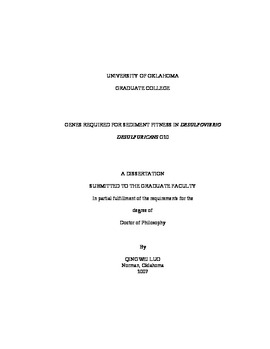| dc.contributor.advisor | Krumholz, Lee R., | en_US |
| dc.contributor.author | Luo, Qingwei. | en_US |
| dc.date.accessioned | 2013-08-16T12:20:37Z | |
| dc.date.available | 2013-08-16T12:20:37Z | |
| dc.date.issued | 2007 | en_US |
| dc.identifier.uri | https://hdl.handle.net/11244/1179 | |
| dc.description.abstract | 97 genes required for sediment fitness of G20 were identified and the identification of chemotaxis genes validated our STM screening method since it would be expected to enhance sediment fitness. The growth of these sediment fitness mutants was monitored in laboratory growth media to determine whether growth rate influenced sediment fitness. Homology with other delta- proteobacteria was determined and the putative sediment functions of many of these genes were described. Amino acid biosynthesis mutants, hydrogenase mutants, and DNA repair mutants were characterized to prove the importance of specific functions for sediment fitness. | en_US |
| dc.description.abstract | A modified version of the signature-tagged mutagenesis (STM) procedure was developed, which incorporated microarray technology to streamline the entire screening process. A mini-Tn10 transposon that is capable of randomly mutagenizing our model sulfate-reducing bacterium was also identified. This system can therefore be applied to other sulfate-reducing bacteria to answer questions of ecological or economical significance. This is the first study using STM to study bacterial environmental fitness. | en_US |
| dc.description.abstract | Preliminary experiments were conducted on Desulfovibrio desulfuricans G20 to obtain some basic information of this bacterium. Strain G20 has a single flagellum and a doubling time of 3.2 hours at 37° C in the lactate-sulfate medium, compared to the doubling time of 7.3 and 5.0 hours for strain Essex6 and strain ASR, respectively. G20 is resistant to several antibiotics including nalidixic acid, spectinomycin, and streptomycin. | en_US |
| dc.description.abstract | The proteomes of the regulatory mutants were analyzed and compared to the proteome of the parent strain. The reproducible and reliable data produced by the accurate mass and time tag approach allow us to compare protein production in the mutants. The results showed that these regulators regulated different sets of genes which may be required for sediment survival, although the regulatory pathways remain to be elucidated. It is evident that the laboratory-adapted strain is different from sediment-adapted strain at the protein level. | en_US |
| dc.format.extent | xx, 208 leaves : | en_US |
| dc.subject | Biology, Microbiology. | en_US |
| dc.subject | Biology, Molecular. | en_US |
| dc.subject | Biology, Ecology. | en_US |
| dc.subject | Mutagenesis. | en_US |
| dc.subject | Anaerobic bacteria. | en_US |
| dc.subject | Desulfovibrio. | en_US |
| dc.subject | Proteomics. | en_US |
| dc.title | Genes required for sediment fitness in Desulfovibrio desulfuricans G20. | en_US |
| dc.type | Thesis | en_US |
| dc.thesis.degree | Ph.D. | en_US |
| dc.thesis.degreeDiscipline | Department of Microbiology and Plant Biology | en_US |
| dc.note | Adviser: Lee R. Krumholz. | en_US |
| dc.note | Source: Dissertation Abstracts International, Volume: 68-04, Section: B, page: 2064. | en_US |
| ou.identifier | (UMI)AAI3261102 | en_US |
| ou.group | College of Arts and Sciences::Department of Microbiology and Plant Biology | |
